Global Clinical Microbiology Market: By Product, By Diseases, By Application, By End User, By Region & Segmental Insights Trends and Forecast, 2024 – 2034
- Industry: Healthcare
- Report ID: TNR-110-1153
- Number of Pages: 420
- Table/Charts : Yes
- June, 2024
- Base Year : 2024
- No. of Companies : 10+
- No. of Countries : 29
- Views : 10099
- Covid Impact Covered: Yes
- War Impact Covered: Yes
- Formats : PDF, Excel, PPT
Clinical microbiology is a specialized branch of laboratory medicine focused on the diagnosis of infectious diseases through the study of microorganisms. It encompasses the identification, characterization, and susceptibility testing of pathogens such as bacteria, viruses, fungi, and parasites that cause infections in humans. Clinical microbiologists employ various techniques and methodologies, including culture-based methods, molecular diagnostics, serological testing, and biochemical assays, to detect and identify microbial pathogens from patient samples such as blood, urine, sputum, and tissues.
The field plays a crucial role in guiding clinical decisions by providing clinicians with accurate information on the type of pathogen causing an infection and its susceptibility to antimicrobial agents. Additionally, clinical microbiology contributes to public health efforts by monitoring antimicrobial resistance, conducting surveillance of infectious diseases, and participating in outbreak investigations. As healthcare evolves with technological advancements and the global burden of infectious diseases changes, clinical microbiology remains essential in ensuring effective diagnosis, treatment, and prevention of infectious diseases worldwide.
Clinical microbiology is driven by several key factors that shape its demand and growth in healthcare settings globally. Firstly, the increasing incidence of infectious diseases, including emerging pathogens and antibiotic-resistant bacteria, underscores the critical role of microbiological testing in accurate diagnosis and effective treatment planning. The demand is further fueled by advancements in diagnostic technologies, such as PCR, MALDI-TOF mass spectrometry, and rapid molecular assays, which enhance the speed and accuracy of pathogen detection.
Additionally, the rise of global travel and migration contributes to the spread of infectious diseases, necessitating robust microbiology testing capabilities for surveillance and outbreak control. Furthermore, healthcare systems’ emphasis on infection prevention and control, coupled with the need for antimicrobial stewardship programs to combat resistance, drives continuous investment in microbiology laboratories and testing infrastructure. As clinical microbiology continues to evolve with technological innovations and public health challenges, its demand remains pivotal in supporting effective patient care and public health initiatives worldwide.
In terms of revenue, the global clinical microbiology market was worth US$ 4.7 Bn in 2023, anticipated to witness CAGR of 5.2% during 2024 – 2034.

Global Clinical Microbiology Market Dynamics
Technological Advancements: Continuous innovations in diagnostic technologies such as molecular diagnostics, next-generation sequencing (NGS), and automation drive market expansion. These advancements improve testing accuracy, throughput, and turnaround times, enhancing clinical microbiology laboratory efficiency.
Increasing Incidence of Infectious Diseases: The rising prevalence of infectious diseases worldwide, including antibiotic-resistant pathogens, fuels demand for diagnostic testing. Clinical microbiology plays a crucial role in identifying pathogens, guiding treatment decisions, and managing outbreaks.
Global Health Security Concerns: Growing concerns over global health security, highlighted by recent pandemics like COVID-19, emphasize the need for robust infectious disease surveillance and rapid diagnostic capabilities. This drives investments in advanced microbiology testing infrastructure and capabilities.
Antimicrobial Stewardship Initiatives: Rising awareness and regulatory efforts to combat antimicrobial resistance (AMR) drive adoption of microbiology testing to optimize antibiotic use, improve patient outcomes, and reduce healthcare costs.
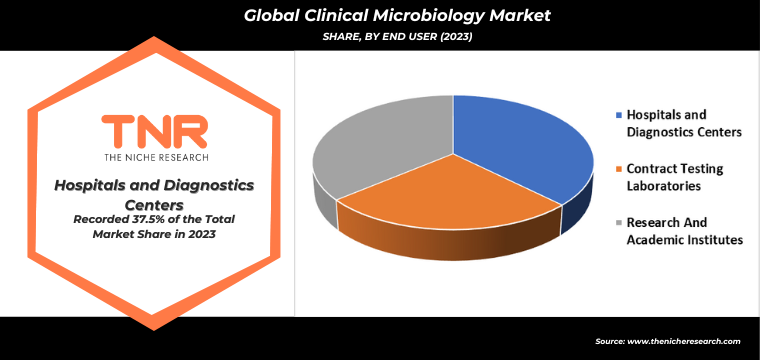
Reagents Segment has Garnered Major Market Share in the Global Clinical Microbiology Market During the Forecast Period (2024 – 2034).
Reagents are vital components in clinical microbiology laboratories, serving as critical demand drivers due to their essential role in diagnostic testing processes. These specialized substances are used to detect and identify pathogens in clinical specimens, enabling microbiologists to accurately diagnose infectious diseases. The demand for reagents in clinical microbiology is fueled by several factors, including the increasing prevalence of infectious diseases globally and the continuous development of new diagnostic methods that require specific reagents for accurate results. Moreover, the rise in antibiotic resistance necessitates advanced reagents that can detect resistant strains and guide appropriate treatment strategies.
Technological advancements in reagent development, such as multiplex PCR assays and automated systems, enhance testing efficiency and accuracy, further driving demand. Additionally, regulatory standards and guidelines mandate the use of certified reagents to ensure the reliability and reproducibility of diagnostic tests. As clinical microbiology laboratories strive to meet the growing demand for rapid and reliable infectious disease diagnostics, the demand for high-quality reagents continues to grow, shaping the future of diagnostic capabilities in healthcare settings.
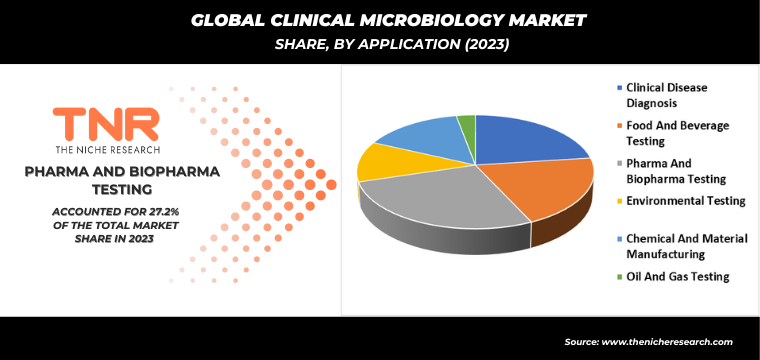
By Diseases Respiratory Diseases Segment had the Highest Share in the Global Clinical Microbiology Market in 2023.
Respiratory diseases drive significant demand for clinical microbiology services due to their prevalence, diverse etiology, and impact on public health. Diseases such as pneumonia, tuberculosis, influenza, and respiratory syncytial virus (RSV) require accurate and timely microbiological testing for effective diagnosis and treatment. Clinical microbiology laboratories play a crucial role in identifying the causative pathogens responsible for respiratory infections, guiding healthcare providers in selecting appropriate antimicrobial therapy and infection control measures.
The emergence of antibiotic-resistant bacteria, including those causing community-acquired pneumonia and healthcare-associated infections, further underscores the need for comprehensive microbial diagnostics to ensure timely intervention and improved patient outcomes. Additionally, the ongoing threat of respiratory epidemics and pandemics, as seen with COVID-19, highlights the critical role of clinical microbiology in outbreak management and public health surveillance. Advances in diagnostic technologies, such as PCR and rapid molecular assays, enhance the efficiency and accuracy of pathogen detection, driving the increasing demand for clinical microbiology services in respiratory disease management globally.
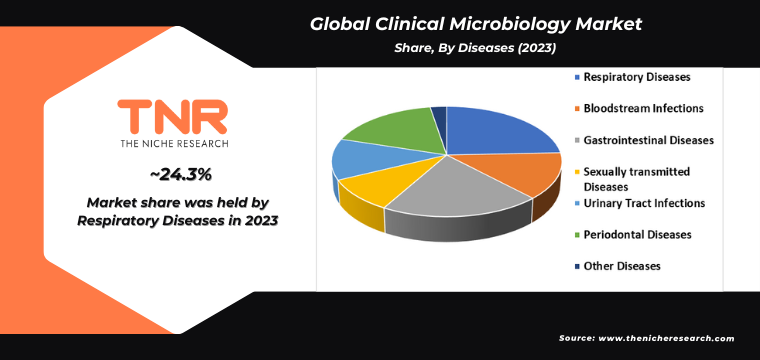
By Region, Europe Dominated the Global Clinical Microbiology Market in 2023.
In Europe, the demand for clinical microbiology services is driven by several pivotal factors shaping the landscape of healthcare diagnostics. The increasing prevalence of infectious diseases, including antibiotic-resistant pathogens, underscores the critical need for accurate and timely microbiological testing. Clinical microbiology laboratories play a crucial role in identifying pathogens, determining antimicrobial susceptibilities, and guiding appropriate treatment strategies, thereby aiding in the management of infectious diseases and reducing healthcare costs associated with ineffective treatments.
Moreover, the rise in global travel and migration contributes to the spread of infectious diseases across borders, necessitating robust diagnostic capabilities to monitor and contain outbreaks. Advancements in technology, such as automation and molecular diagnostics, enhance the efficiency and accuracy of microbial identification and characterization, driving the adoption of these services in clinical practice. As healthcare systems prioritize infection control and antimicrobial stewardship, the demand for clinical microbiology services continues to grow, positioning it as a cornerstone of modern healthcare in Europe.
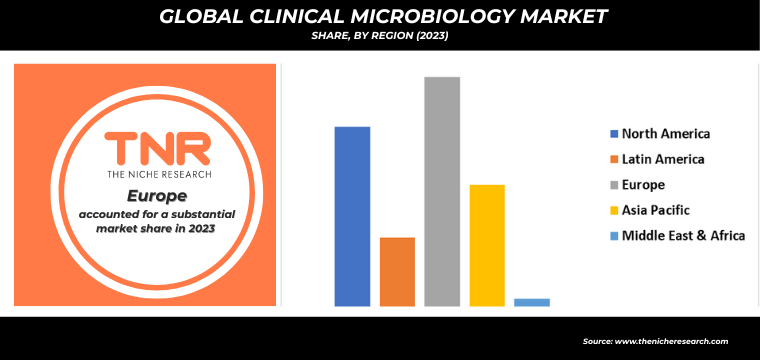
Competitive Landscape: Global Clinical Microbiology Market:
- 3M
- Abbott
- Agilent Technologies Inc.
- BD
- BioMérieux
- Bio-Rad Laboratories
- Bruker
- Danaher
- Diagnostica Longwood SL
- Hoffmann-La Roche Ltd
- Hologic Inc.
- Memmert GmbH + Co.KG
- Merck KGaA
- QIAGEN
- Thermo Fisher Scientific Inc.
- Other Industry Participants
Global Clinical Microbiology Market Scope
| Report Specifications | Details |
| Market Revenue in 2023 | US$ 4.7 Bn |
| Market Size Forecast by 2034 | US$ 8.2 Bn |
| Growth Rate (CAGR) | 5.2% |
| Historic Data | 2016 – 2022 |
| Base Year for Estimation | 2023 |
| Forecast Period | 2024 – 2034 |
| Report Inclusions | Market Size & Estimates, Market Dynamics, Competitive Scenario, Trends, Growth Factors, Market Determinants, Key Investment Segmentation, Product/Service/Solutions Benchmarking |
| Segments Covered | By Product, By Diseases, By Application, By End User, By Region |
| Regions Covered | North America, Europe, Asia Pacific, Middle East & Africa, Latin America |
| Countries Covered | U.S., Canada, Mexico, Rest of North America, France, The UK, Spain, Germany, Italy, Nordic Countries (Denmark, Finland, Iceland, Sweden, Norway), Benelux Union (Belgium, The Netherlands, Luxembourg), Rest of Europe, China, Japan, India, New Zealand, Australia, South Korea, Southeast Asia (Indonesia, Thailand, Malaysia, Singapore, Rest of Southeast Asia), Rest of Asia Pacific, Saudi Arabia, UAE, Egypt, Kuwait, South Africa, Rest of Middle East & Africa, Brazil, Argentina, Rest of Latin America |
| Key Players | 3M, Abbott, Agilent Technologies Inc., BD, BioMérieux, Bio-Rad Laboratories, Bruker, Danaher, Diagnostica Longwood SL, F. Hoffmann-La Roche Ltd, Hologic Inc., Memmert GmbH + Co.KG, Merck KGaA, QIAGEN, Thermo Fisher Scientific Inc. |
| Customization Scope | Customization allows for the inclusion/modification of content pertaining to geographical regions, countries, and specific market segments. |
| Pricing & Procurement Options | Explore purchase options tailored to your specific research requirements |
| Contact Details | Consult With Our Expert
Japan (Toll-Free): +81 663-386-8111 South Korea (Toll-Free): +82-808- 703-126 Saudi Arabia (Toll-Free): +966 800-850-1643 United Kingdom: +44 753-710-5080 United States: +1 302-232-5106 E-mail: askanexpert@thenicheresearch.com
|
Global Clinical Microbiology Market
By Product
- Laboratory Instruments
- Incubators
- Gram Stainers
- Bacterial Colony Counters
- Autoclave Sterilizers
- Petri Dish Fillers
- Automated Culture System
- Microbiology Analyzers
- Molecular Diagnostic Instruments
- Microscopes
- Mass Spectrometers
- Reagents
By Diseases
- Respiratory Diseases
- Bloodstream Infections
- Gastrointestinal Diseases
- Sexually transmitted Diseases
- Urinary Tract Infections
- Periodontal Diseases
- Other Diseases
By Application
- Clinical Disease Diagnosis
- Food And Beverage Testing
- Pharma And Biopharma Testing
- Environmental Testing
- Chemical And Material Manufacturing
- Oil And Gas Testing
By End User
- Hospitals and Diagnostics Centers
- Contract Testing Laboratories
- Research And Academic Institutes
By Region
- North America (U.S., Canada, Mexico, Rest of North America)
- Europe (France, The UK, Spain, Germany, Italy, Nordic Countries (Denmark, Finland, Iceland, Sweden, Norway), Benelux Union (Belgium, The Netherlands, Luxembourg), Rest of Europe)
- Asia Pacific (China, Japan, India, New Zealand, Australia, South Korea, Southeast Asia (Indonesia, Thailand, Malaysia, Singapore, Rest of Southeast Asia), Rest of Asia Pacific)
- Middle East & Africa (Saudi Arabia, UAE, Egypt, Kuwait, South Africa, Rest of Middle East & Africa)
- Latin America (Brazil, Argentina, Rest of Latin America)
Report Layout:
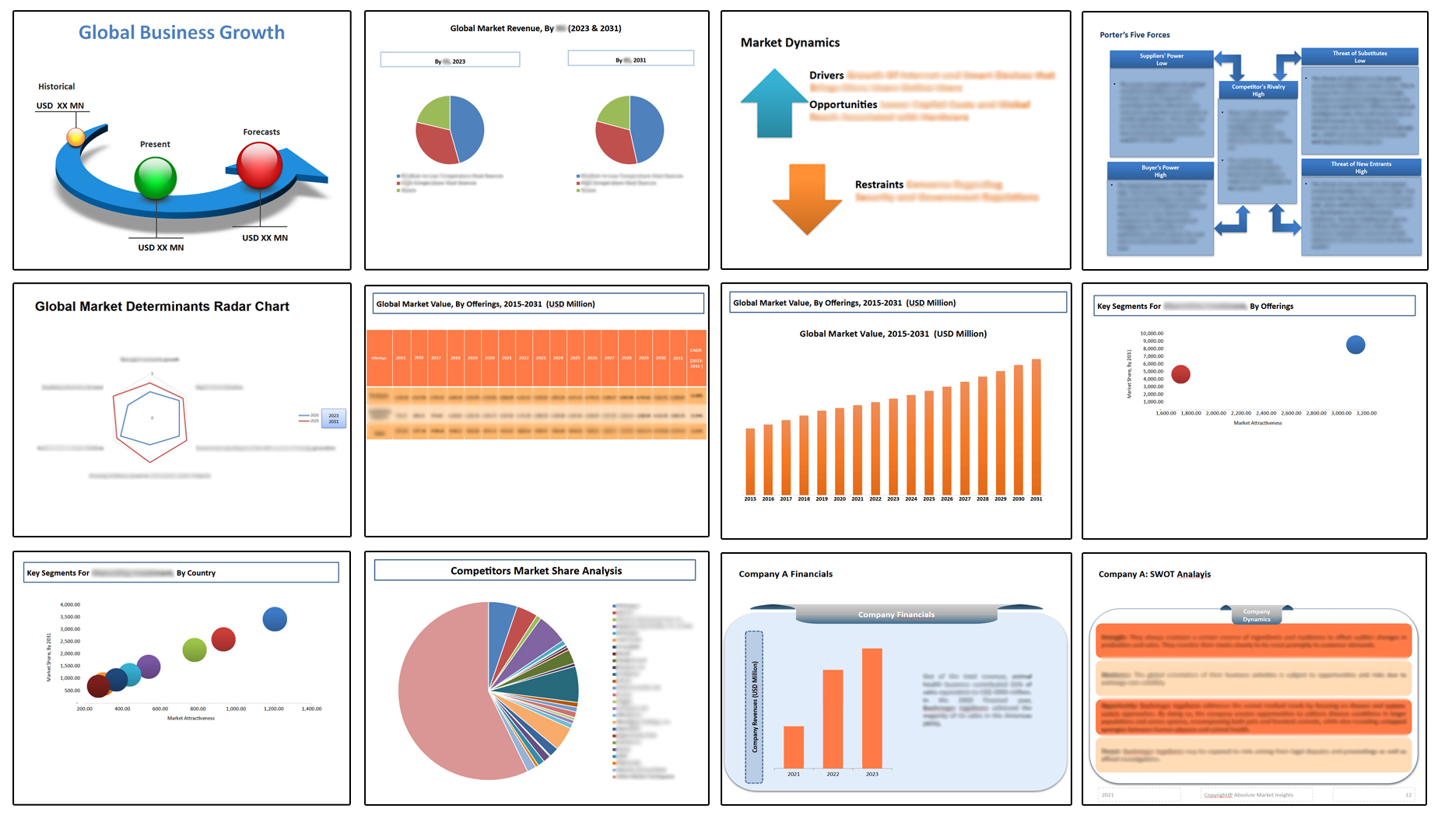
Table of Contents
Note: This ToC is tentative and can be changed according to the research study conducted during the course of report completion.
**Exclusive for Multi-User and Enterprise User.
Global Clinical Microbiology Market
By Product
- Laboratory Instruments
- Incubators
- Gram Stainers
- Bacterial Colony Counters
- Autoclave Sterilizers
- Petri Dish Fillers
- Automated Culture System
- Microbiology Analyzers
- Molecular Diagnostic Instruments
- Microscopes
- Mass Spectrometers
- Reagents
By Diseases
- Respiratory Diseases
- Bloodstream Infections
- Gastrointestinal Diseases
- Sexually transmitted Diseases
- Urinary Tract Infections
- Periodontal Diseases
- Other Diseases
By Application
- Clinical Disease Diagnosis
- Food And Beverage Testing
- Pharma And Biopharma Testing
- Environmental Testing
- Chemical And Material Manufacturing
- Oil And Gas Testing
By End User
- Hospitals and Diagnostics Centers
- Contract Testing Laboratories
- Research And Academic Institutes
By Region
- North America (U.S., Canada, Mexico, Rest of North America)
- Europe (France, The UK, Spain, Germany, Italy, Nordic Countries (Denmark, Finland, Iceland, Sweden, Norway), Benelux Union (Belgium, The Netherlands, Luxembourg), Rest of Europe)
- Asia Pacific (China, Japan, India, New Zealand, Australia, South Korea, Southeast Asia (Indonesia, Thailand, Malaysia, Singapore, Rest of Southeast Asia), Rest of Asia Pacific)
- Middle East & Africa (Saudi Arabia, UAE, Egypt, Kuwait, South Africa, Rest of Middle East & Africa)
- Latin America (Brazil, Argentina, Rest of Latin America)
The Niche Research approach encompasses both primary and secondary research methods to provide comprehensive insights. While primary research is the cornerstone of our studies, we also incorporate secondary research sources such as company annual reports, premium industry databases, press releases, industry journals, and white papers.
Within our primary research, we actively engage with various industry stakeholders, conducting paid interviews and surveys. Our meticulous analysis extends to every market participant in major countries, allowing us to thoroughly examine their portfolios, calculate market shares, and segment revenues.
Our data collection primarily focuses on individual countries within our research scope, enabling us to estimate regional market sizes. Typically, we employ a bottom-up approach, meticulously tracking trends in different countries. We analyze growth drivers, constraints, technological innovations, and opportunities for each country, ultimately arriving at regional figures.Our process begins by examining the growth prospects of each country. Building upon these insights, we project growth and trends for the entire region. Finally, we utilize our proprietary model to refine estimations and forecasts.
Our data validation standards are integral to ensuring the reliability and accuracy of our research findings. Here’s a breakdown of our data validation processes and the stakeholders we engage with during our primary research:
- Supply Side Analysis: We initiate a supply side analysis by directly contacting market participants, through telephonic interviews and questionnaires containing both open-ended and close-ended questions. We gather information on their portfolios, segment revenues, developments, and growth strategies.
- Demand Side Analysis: To gain insights into adoption trends and consumer preferences, we reach out to target customers and users (non-vendors). This information forms a vital part of the qualitative analysis section of our reports, covering market dynamics, adoption trends, consumer behavior, spending patterns, and other related aspects.
- Consultant Insights: We tap into the expertise of our partner consultants from around the world to obtain their unique viewpoints and perspectives. Their insights contribute to a well-rounded understanding of the markets under investigation.
- In-House Validation: To ensure data accuracy and reliability, we conduct cross-validation of data points and information through our in-house team of consultants and utilize advanced data modeling tools for thorough verification.
The forecasts we provide are based on a comprehensive assessment of various factors, including:
- Market Trends and Past Performance (Last Five Years): We accurately analyze market trends and performance data from preceding five years to identify historical patterns and understand the market’s evolution.
- Historical Performance and Growth of Market Participants: We assess the historical performance and growth trajectories of key market participants. This analysis provides insights into the competitive landscape and individual company strategies.
- Market Determinants Impact Analysis (Next Eight Years): We conduct a rigorous analysis of the factors that are projected to influence the market over the next eight years. This includes assessing both internal and external determinants that can shape market dynamics.
- Drivers and Challenges for the Forecast Period:Identify the factors expected to drive market growth during the forecast period, as well as the challenges that the industry may face. This analysis aids in deriving an accurate growth rate projection.
- New Acquisitions, Collaborations, or Partnerships: We keep a close watch on any new acquisitions, collaborations, or partnerships within the industry. These developments can have a significant impact on market dynamics and competitiveness.
- Macro and Micro Factors Analysis:A thorough examination of both macro-level factors (e.g., economic trends, regulatory changes) and micro-level factors (e.g., technological advancements, consumer preferences) that may influence the market during the forecast period.
- End-User Sentiment Analysis: To understand the market from the end-user perspective, we conduct sentiment analysis. This involves assessing the sentiment, preferences, and feedback of the end-users, which can provide valuable insights into market trends.
- Perspective of Primary Participants: Insights gathered directly from primary research participants play a crucial role in shaping our forecasts. Their perspectives and experiences provide valuable qualitative data.
- Year-on-Year Growth Trend: We utilize a year-on-year growth trend based on historical market growth and expected future trends. This helps in formulating our growth projections, aligning them with the market’s historical performance.
Research process adopted by TNR involves multiple stages, including data collection, validation, quality checks, and presentation. It’s crucial that the data and information we provide add value to your existing market understanding and expertise. We have also established partnerships with business consulting, research, and survey organizations across regions and globally to collaborate on regional analysis and data validation, ensuring the highest level of accuracy and reliability in our reports.









